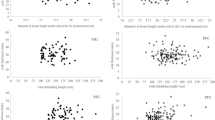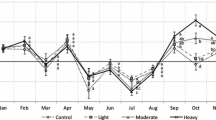Abstract
Acorn production is one of the most important products in silvopastoral systems in the Mediterranean region. In the present study we carried out two preliminary trials to analyze the distribution of production over time and the effect of pruning. The objective was to develop tools to manage this valuable resource within these systems. In the first part of the study, we analyzed the total acorn production of a holm oak stand, and its seasonal distribution (October–January) over two years (1997–1998 and 1998–1999) in five sites in the southwest of Spain. Mean total acorn production ranged from 590 to 830 kg ha−1. There was considerable variation between the different sites and years studied, as was expected from studies on other oak species. A comparison was also made of acorn production, comparing annual acorn production between 40 pruned and 40 non-pruned trees, for the period 1994–1999. There was an interaction between ‘pruning treatment’ and ‘year’. Pruning, significantly decreased acorn production in all but two years when production was above the average, whereas production was not affected by pruning the three years that acorn yield was below the average. The study of acorn production and the analysis of the effect of pruning, needs to be studied over a longer time period.



Similar content being viewed by others
References
Abrahamson WG, Layne JN (2003) Long-term patterns of acorn production for five oak species in xeric Florida uplands. Ecol 84:2476–2492
Aizen MA, Woodcock H (1992) Latitudinal trends in acorn size in eastern North American species of Quercus. Can J Bot 70:1218–1222
Álvarez S, Morales B, Bejarano L (2004) Estudio preliminar de la influencia de la poda en la producción de bellota en El Encinar de Espeja (Salamanca). In: García B, García A, Vázquez B, Zabalgogeazcoa I (eds) XLIV Reunión Científica de la SEEP, Salamanca
Carbonero MD, Fernández P, Blázquez A, Navarro R (2003) Evaluación de la producción y del calibre de bellotas de Quercus ilex L. subsp. ballota (Desf) Samp a lo largo de un ciclo de poda: resultados de las campañas 2001–2002 y 2002–2003. In: Robles A, Ramos E, Morales MC, de Simón E, González-Rebollar JL, Boza J (eds) XLIII Reunión Científica de la SEEP, Granada
Espárrago F, Vázquez FM, Burzaco A, Pérez MC (1993) Producción de bellota en Quercus rotundifolia Lam.: variabilidad anual e importancia económica. In: SECF (eds) I Congreso Forestal Español, Pontevedra
García D, Ramos S, Josemaría A, Isabel B, Blanco J, Lucas AB, Aguilar S, Doncel E, Vázquez FM (2003) Consumo de bellotas por el cerdo ibérico durante la montanera. Sólo Cerdo Ibérico 10:65–71
Gea-Izquierdo G, Cañellas I, Montero G (2006) Fruit Production in Iberian Dehesas. Investigación Agraria, Sistemas y Recursos Forestales 15(3):339–354
Gómez JM, Pérez M (1996) The “dehesas”: silvopastoral systems in semiarid Mediterranean regions with poor soils, seasonal climate and extensive utilisation In: Étienne M (eds) Western European silvopastoral systems. INRA, Paris
Herrera CM, Jordano P, Guitián J, Traveset A (1998) Annual variability in seed production by woody plants and the masting concept: reassessment of principles and relationship to pollination and seed dispersal. Am Nat 152:76–594
Hubert M, Courrand R (2002) Elagage et taille de formation des arbres forestieres (3e éd). Institut Developpement Forestier, Paris
Joffre R, Vacher J, de los Llanos C, Long G (1988) The dehesa: an agrosilvopastoral system of the Mediterranean region with special reference to the Sierra Morena area of Spain. Agrofor Syst 6:71–96
Koenig WD, Knops JMH, Carmen WJ, Stanback MT, Mumme RL (1994) Estimating acorn crops using visual surveys. Can J For Res 24:2105–2112
Koenig WD, Knops MH (2000) Patterns of annual seed production by Northern Hemisphere trees: a global perspective. Am Nat 155:59–69
López-Bote CJ (1998) Sustained utilization of the Iberian pig breed. Meat Sci 49:17–27
Maeto K, Ozaki K (2003) Prolonged diapause of specialist seed-feeders makes predator satiation unstable in masting of Quercus crispula. Oecol 137:392–398
Martín A, Infante JM, García-Gordo J, Merino J, Fernández-Alés R (1998) Producción de bellotas en montes y dehesas del suroeste español. Pastos 28(2):237–248
Martín-Vicente A, Fernández-Alés R (2006) Long term persistente of dehesas. Evidences from history. Agroforest Syst 67:19–28
Masaka K, Sato H (2002) Acorn production by Kashiwa oak in a coastal forest under fluctuating weather conditions. Can J For Res 32:9–15
Nieto R, Ribera M, García MA, Aguilera JF (2002) Amino acid availability and energy value of acorn in the Iberian pig. Livest Prod Sci 77:227–239
Pinto-Correia T (1993) Threatened landscape in Alentejo, Portugal: the ‘montado’ and other ‘agro-silvopastoral’ systems. Landscape Urban Plann 24:43–48
Porras C (1998) Efecto de la poda de la encina (Quercus rotundifolia Lam.) en los aspectos de producción y del grosor de la bellota. In: SEEP (ed) XXXVIII Reunión Científica de la SEEP, Soria 1998
San Miguel A (1994) La dehesa española: origen, tipología, características y gestión. Fundación Conde del Valle de Salazar, Madrid
Soria FJ, Cano E, Ocete ME (1996) Efectos del ataque de fitófagos perforadores en el fruto de la encina (Quercus rotundifolia Lam.). Bol San Veg Plagas 22:427–432
Soria FJ, Jiménez A, Villagrán, Ocete ME (2005) Relación entre la colonización de la encina por Curculio elephas Gyllenhal (Coleoptera, Curculionidae) y el periodo de caída natural de frutos. Bol San Veg Plagas 31:365–375
Sork VL, Bramble J, Sexton O (1993) Ecology of mast fruiting in three species of North American deciduous oaks. Ecol 74:528–541
Torrent JA (1963) Montaneras en los últimos diez años: 1953–1962. In: SEEP (ed) IV Reunión Científica de la SEEP, Cáceres-Salamanca, 1963
Zulueta J, Cañellas I (1989) Método para estimar la producción real de bellota en un alcornocal. Scient Gerund 1:115–119
Author information
Authors and Affiliations
Corresponding author
Rights and permissions
About this article
Cite this article
Cañellas, I., Roig, S., Poblaciones, M. et al. An approach to acorn production in Iberian dehesas. Agroforest Syst 70, 3–9 (2007). https://doi.org/10.1007/s10457-007-9034-0
Published:
Issue Date:
DOI: https://doi.org/10.1007/s10457-007-9034-0




